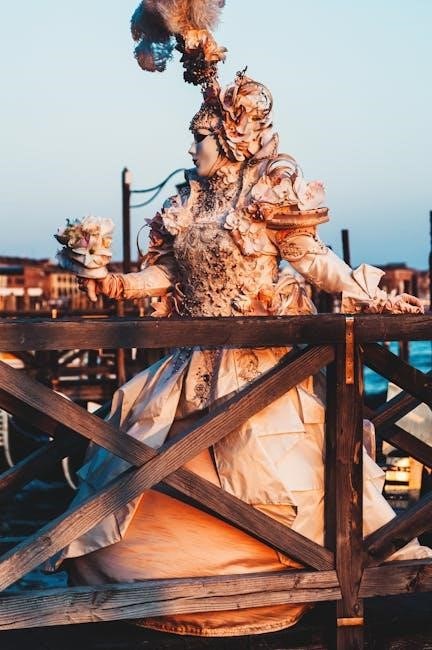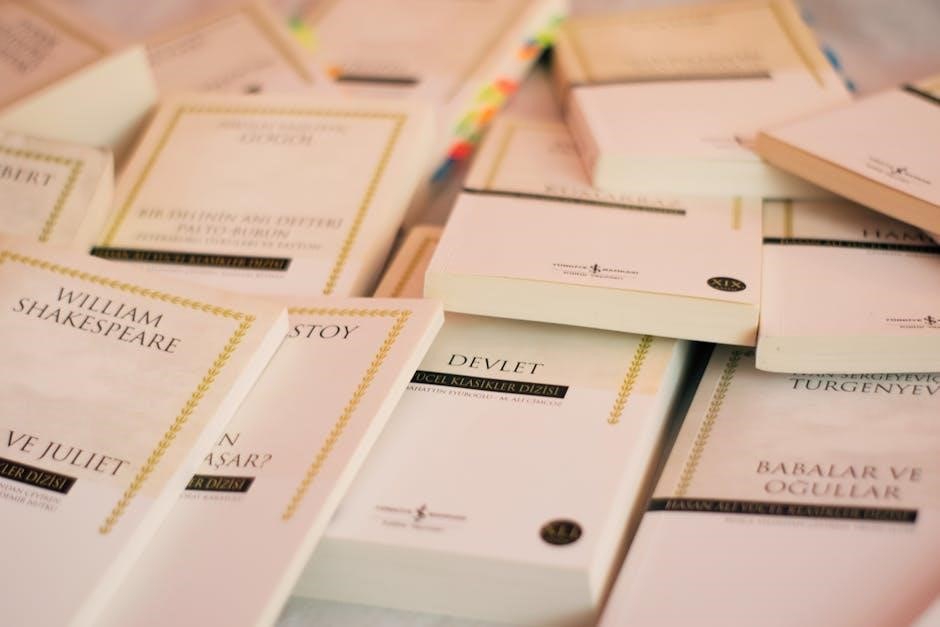
Act 2 Study Guide: Romeo and Juliet

Act 2 of Romeo and Juliet explores themes of love, fate, and conflict. Key scenes include Romeo’s soliloquy, the balcony encounter, and the secret marriage. Analyze how characters develop and tensions rise, shaping the tragic trajectory.
2.1 Prologue: Setting the Tone for Act 2
The prologue of Act 2 in Romeo and Juliet serves as a narrative bridge, transitioning the audience from the events of Act 1 to the unfolding drama. It highlights the ongoing feud between the Montagues and Capulets, emphasizing the tense atmosphere in Verona. The Chorus reiterates the tragic fate of the star-crossed lovers, foreshadowing the inevitable consequences of their love. This prologue sets a somber and introspective tone, preparing the audience for the emotional depth of Act 2. By summarizing the lovers’ plight, it underscores the themes of fate, impulsivity, and the destructive nature of hatred. The prologue also introduces the idea of secrecy, as Romeo and Juliet’s relationship deepens, adding layers of urgency and suspense. Through its poetic language, the prologue encapsulates the central conflict, ensuring the audience remains engaged with the unfolding tragedy.
2.2 Scene 1: Romeo’s Soliloquy and His Search for Juliet
Scene 1 of Act 2 opens with Romeo’s soliloquy, showcasing his deep infatuation with Juliet. Having left the Capulet’s feast, Romeo finds himself unable to return home, driven instead by an overwhelming desire to be near Juliet. He climbs a wall bordering the Capulet orchard, demonstrating his willingness to risk danger for love. Romeo’s soliloquy reveals his emotional turmoil, as he struggles to reconcile his passion for Juliet with the societal barriers separating them. His words are filled with longing and determination, highlighting his transformation from a lovesick youth pining for Rosaline to a man deeply committed to Juliet. This scene sets the stage for the iconic balcony encounter, emphasizing Romeo’s proactive pursuit of love despite the obstacles. Through his soliloquy, Shakespeare illustrates Romeo’s romantic idealism and the intensity of his emotions, while also foreshadowing the challenges the lovers will face.
2.3 Scene 2: The Iconic Balcony Scene
The balcony scene is one of the most iconic moments in Romeo and Juliet, where Juliet professes her love for Romeo in a soliloquy, unaware that he is listening. Standing beneath her balcony, Romeo overhears Juliet’s heartfelt declaration, in which she laments the feud between their families and wishes Romeo could shed his name. When Romeo reveals himself, Juliet is initially startled but quickly warms to the idea of being with him. Their exchange is filled with poetic language and emotional intensity, showcasing the depth of their feelings. Juliet famously declares, “What’s in a name? That which we call a rose / By any other name would smell as sweet.” Romeo, emboldened by love, promises to marry her, and they make plans to be together despite the obstacles. This scene highlights Juliet’s independence and Romeo’s audacity, while also deepening the romantic tension between them. Their love becomes a beacon of hope amidst the hatred surrounding them.
2.4 Scene 3: Romeo and Friar Laurence’s Conversation
In this pivotal scene, Romeo visits Friar Laurence to share the news of his newfound love for Juliet and to seek his help in marrying her. Romeo, still enchanted by Juliet, pleads with the Friar to officiate their union, believing their love can end the feud between their families. Friar Laurence, though initially hesitant, agrees to help, hoping their marriage might bring peace to Verona. He advises Romeo to approach Juliet’s father for her hand but suggests a secret marriage if that fails. Romeo’s impulsive nature is evident as he presses the Friar for immediate action. The Friar, while cautious, is optimistic about the potential for reconciliation through their union. This conversation underscores the themes of love’s power to overcome hatred and the role of fate, as the Friar’s decision sets the stage for the tragic events that follow. The scene also highlights Romeo’s emotional intensity and the Friar’s philosophical approach to solving conflicts.
2.5 Scene 4: Mercutio and Benvolio’s Banter
In this lively scene, Mercutio and Benvolio engage in their usual witty banter as they search for Romeo. Mercutio teases Benvolio about his temper, while Benvolio counters with jokes about Mercutio’s lively nature. Their conversation reveals their camaraderie and shared concern for Romeo, who has been absent since falling in love with Juliet. Mercutio mocks Romeo’s infatuation, unaware of the depth of his friend’s feelings. Benvolio, more cautious, tries to defend Romeo while also expressing skepticism about his friend’s sudden change in behavior. The scene provides comic relief, showcasing Mercutio’s quick wit and Benvolio’s more measured approach. It also highlights the loyalty and friendship between the three men. However, beneath the humor lies a sense of unease, as their discussion foreshadows the potential dangers of Romeo’s secretive relationship with Juliet. This exchange underscores the theme of loyalty versus conflict, as their bond is soon tested by the unfolding events. The banter serves as a contrast to the more serious and tragic elements of the play, offering a moment of levity before the tension escalates.
2.6 Scene 5: Juliet’s Anticipation of Romeo
In Scene 5 of Act 2, Juliet eagerly awaits Romeo’s visit to her balcony, showcasing her deep longing and impatience. Her soliloquy reveals her emotional turmoil as she wishes for night to fall quickly, symbolizing her desire to unite with Romeo. Juliet’s words are filled with passion and urgency, highlighting the intensity of her love. She expresses frustration with time moving slowly, emphasizing the theme of love’s impatience. Juliet also contemplates the risks of their relationship, demonstrating her awareness of the potential consequences. Her dialogue is rich with imagery, particularly the contrast between light and dark, symbolizing her desire to escape the constraints of her family feud. This scene underscores Juliet’s determination and willingness to defy societal norms for love. It also sets the stage for the secret marriage, as Juliet’s anticipation builds toward the climactic moment when she and Romeo will be together. Her emotions in this scene illustrate the profound impact Romeo has had on her life, further deepening the audience’s connection to her character. The tension in this scene mirrors the overarching conflict of the play, foreshadowing the tragic events that will unfold.
2.7 Scene 6: The Secret Marriage Ceremony
In Scene 6 of Act 2, Romeo and Juliet secretly marry in Friar Laurence’s cell, marking a pivotal moment in the play. The ceremony is intimate, with only Friar Laurence and the Nurse present, highlighting the clandestine nature of their union. Romeo and Juliet exchange vows, expressing their deep commitment to each other. Friar Laurence agrees to perform the marriage, believing it could end the feud between their families. Despite the rushed and secretive circumstances, the couple’s love shines through, filled with hope and optimism. Juliet, in particular, is determined to follow her heart, even in the face of societal obstacles. The scene emphasizes the theme of love conquering all, yet subtly hints at the impending tragedy. The marriage solidifies their bond but also sets in motion the chain of events leading to their downfall. This scene is crucial for understanding the characters’ motivations and the escalating tension in the story.
2.8 The Role of Friar Laurence in Act 2
Friar Laurence plays a central role in Act 2, acting as a mediator and advisor to both Romeo and Juliet. His primary goal is to end the feud between the Montagues and Capulets, believing that the union of the two lovers could bring peace. He agrees to marry Romeo and Juliet in secret, hoping their love will eventually unite their families. Friar Laurence’s wisdom and experience are evident as he counsels Romeo, urging patience and caution. However, his decision to marry the couple without their parents’ consent introduces significant risk, showcasing his complex mix of optimism and naivety. Friar Laurence also provides solace to Juliet when she learns of Romeo’s banishment, devising a plan to reunite them. His actions highlight his deep empathy and desire to protect the young lovers, but they also set in motion the tragic events that unfold. Through his role, Shakespeare portrays Friar Laurence as a well-meaning but flawed figure whose attempts to help ultimately contribute to the play’s devastating conclusion.

2.9 Themes in Act 2: Love vs. Hate
Act 2 of Romeo and Juliet delves deeply into the contrasting themes of love and hate, which drive the play’s emotional core. Love is portrayed as a transformative and redemptive force, particularly through Romeo and Juliet’s relationship. Their balcony scene exemplifies the purity and intensity of their bond, as they exchange vows of devotion despite the danger. Love also inspires hope, as seen in Friar Laurence’s belief that their union could end the families’ feud. However, hate remains a pervasive force, embedded in the long-standing animosity between the Montagues and Capulets. This hatred creates tension, forcing the lovers to keep their relationship secret. The duality of these themes is evident in the characters’ actions, as love prompts selflessness and bravery, while hate fosters division and violence. Act 2 highlights how love and hate coexist, with love offering a glimmer of hope amidst the conflict. Yet, the enduring presence of hatred sets the stage for the tragic events that will unfold, underscoring the destructive power of unresolved animosity.

2.10 Motifs in Act 2: Fate vs. Free Will
Act 2 of Romeo and Juliet explores the motif of fate versus free will, a central theme in the play. Romeo and Juliet believe their love is destined, suggesting fate’s role in their lives. Romeo’s impulsive decisions, such as scaling Juliet’s balcony and proposing marriage, illustrate his belief that fate guides him. Juliet also feels an inevitable pull toward Romeo, as seen in her soliloquy where she questions fate’s control. However, their choices, like agreeing to marry in secret, show how they exert free will despite societal constraints. Friar Laurence’s involvement adds complexity, as he believes their union can alter fate and end the families’ feud. The tension between fate and free will is evident in the characters’ struggles to navigate their love amidst predetermined animosity. Act 2 highlights how the characters’ choices, driven by love and hope, attempt to defy fate, setting the stage for the tragic consequences of their actions. This interplay between fate and free will underscores the inevitability of their doomed love story, leaving the audience questioning whether their fate was sealed from the start or shaped by their decisions.
2.11 Character Development in Act 2: Romeo and Juliet
In Act 2, Romeo and Juliet undergo significant character development, revealing deeper aspects of their personalities and motivations. Romeo, once infatuated with Rosaline, transitions to a profound and passionate love for Juliet, showcasing his emotional depth and impulsiveness. His decision to marry Juliet despite the families’ feud highlights his belief in fate and his willingness to risk everything for love. Juliet, initially portrayed as obedient and naive, evolves into a determined and independent individual. Her famous balcony soliloquy demonstrates her longing for autonomy and her deep affection for Romeo, emphasizing her growth from a sheltered girl to a woman willing to defy societal expectations. The secret marriage further solidifies their commitment, as they take control of their lives despite the obstacles. Through their actions and dialogue, Shakespeare illustrates how their love accelerates their maturation, transforming them into individuals capable of making life-altering decisions. This development sets the stage for the tragic consequences of their choices, as their love becomes both their greatest strength and their ultimate downfall.
2.12 Conflict and Tension in Act 2
Act 2 of Romeo and Juliet is filled with escalating conflict and tension, primarily driven by the families’ animosity and the lovers’ secretive actions. The feud between the Montagues and Capulets creates an undercurrent of hostility, while Romeo and Juliet’s decision to marry in secret intensifies the emotional stakes. The balcony scene showcases their deepening love, but their families’ hatred looms as a constant threat. Mercutio’s skepticism of Romeo’s infatuation adds humor yet subtly highlights the tension. Friar Laurence’s risky plan to unite the lovers through marriage introduces moral and ethical dilemmas, as his actions could either resolve or exacerbate the conflict. Meanwhile, Juliet’s parents’ arrangement for her to marry Paris creates external pressure, forcing Juliet to choose between obedience and her love for Romeo. These intertwining conflicts build suspense, as the characters’ choices lead them closer to a tragic confrontation. The tension is further heightened by the characters’ awareness of the inevitable consequences of their actions, creating a sense of inevitability that propels the story toward its heartbreaking conclusion.

2.13 Symbolism in Act 2: The Balcony and Light/Dark Imagery
Act 2 of Romeo and Juliet is rich in symbolism, particularly through the balcony and light/dark imagery. The balcony represents Juliet’s confinement and the divide between her private emotions and the public world. It serves as a bridge between Romeo and Juliet, symbolizing their longing and connection despite the obstacles separating them. Light imagery, such as the “east” and “sun,” is used to describe Juliet, symbolizing purity, beauty, and hope. Conversely, darkness represents the secrecy and danger surrounding their love, as well as the looming tragedy. Romeo often associates Juliet with light, contrasting with the darkness of their families’ feud. This imagery highlights the conflict between love and hate, purity and corruption. The interplay of light and dark underscores the transient nature of their happiness and foreshadows the eventual darkness of their fate. These symbols create a vivid backdrop for the emotional and thematic development of the play, emphasizing the timelessness and universality of Shakespeare’s exploration of love and conflict.